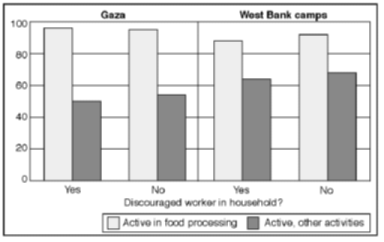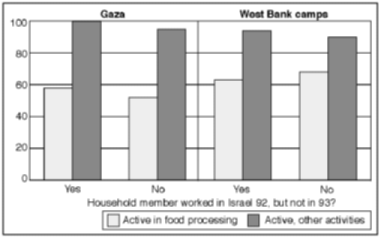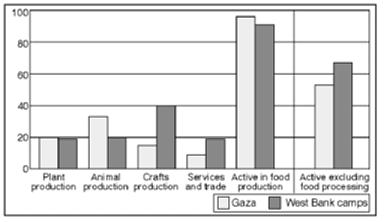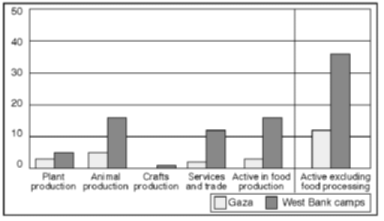
|
|
(Chapter 3)
Household income-generating activities See table 3.1 to 3.18 in appendix 4 for references to this section. The relation between household income-generating activities and individual labour activity has already been discussed in the employment chapter. We will now complete the picture by turning to the economic significance of such activities. Household income-generating activities are, as we noted, characterized by their essentially supplementary nature, rather than for example by the fact that they are usually carried out in a domestic setting. Such activities may still yield important economic benefits for households, through sale or barter of products, and in particular through saving on household consumption expenditures. It is reasonable to expect households to try to increase their income-generating activities to compensate for the reduction in income from formal employment after the border closure. Contrary to expectations, we found that neither persons outside the labour force, nor the "under-utilized", nor those who lost employment in Israel between 1992 and 1993 are more involved in household production than the average population. For individuals, engaging in household production thus seem to be a supplement rather than an alternative to formal labour activity. One explanation could be that the reservation wage of many of those who fail to obtain formal employment is higher than the income level which can be expected from household activities. The employment chapter showed that income-generating household activities primarily are conducted by middle-aged or elderly women. Because formal labour activity among these groups is very low, their reservation wage may be expected to be lower than for those (males) who aspire to formal jobs. One possible hypothesis is thus that other household members (with lower reservation wages) have increased their involvement in household production so as to compensate for the overall loss of formal labour income in the household. To investigate this "intra-household compensation" hypothesis, we asked respondents about changes in the household's output of various income-generating activities since the summer of 1992. Figure 3.1 presents a regional picture of changes in the output of those activities conducted by at least 5% of the households in the sample.
Figure 3.1 Household production changes, by main geographical area. Percentage
of all households in each area Figure 3.1 does not support the "intra-household compensation" hypothesis. On the contrary, activities even show a declining tendency with regard to activity for crafts, and especially in the West Bank refugee camps. (There may, however, be a tendency for respondents to report "no change".) Breaking down results for Gaza by refugee status and type of locality does not reveal significant differences in this pattern. Nor could we find any systematic influence from household size or the household head's individual characteristics (gender, age and education). Investigation of prevalence of income-generating activities specifically in households comprising "discouraged workers", under-utilized workers, or households where the head or other members lost employment in Israel, further confirms that the "intra-household compensation" hypothesis can be rejected. Figures 3.2, 3.3 and 3.4 do not show a higher prevalence of income-generating activities in households including "discouraged workers" or members who lost employment in Israel, or under-utilized workers.
Figure 3.2 Household production, by discouraged workers in household. Percentage
of all households in each area
Figure 3.3 Household production, by workers who lost employment in Israel in
household. Percentage of all households in each area
Figure 3.4 Household production, by under-utilized workers in household. Percentage
of all households in each area Figure 3.8 (concerning household size and production) shows that the share of households engaged in such production increases with increasing household size. As shown by figure 3.5 the share of households with one or more discouraged or under-utilized worker(s), or person(s) who lost employment in Israel do, however, also increases with household size. The somewhat higher prevalence of household production in households with under-utilized workers is most likely due to effects of household size.
Figure 3.5 Labour force categories for household members, by household size. Percentage
of all households in each area Household production thus does not seem to play any (short-term) compensatory role, neither at the individual nor at the household level. The "intra-household compensation" hypothesis must be rejected. Why have household income-generating activities not shown an increase in response to the drop in income after the border closure? Rejection of the "intra-household compensation" hypothesis does not, after all, necessarily imply that the primary agents in household activities, middle aged and older women, also have too high reservation wages for this kind of production. Bearing in mind that formal labour activity, and hence reservation wages, are low among these persons, meagre revenues from household production may only partly explain the lack of increase in output. Non-labour income, e.g. support from UNRWA, could have been expected to raise the reservation wage threshold for initiating low productivity production. Much UNRWA support, however, is provided in kind; this means it may be used as input in for example food processing, making it complementary rather than alternative to at least some types of household production. Another possible explanation for the lack of increase in household production may be found in the "constraints in production" hypothesis. This hypothesis assumes that household production is constrained by lack of land, water, raw materials or manpower, or that some time must elapse before production can be initiated or increased. The constraining factors must, of course, be expected to vary with the type of activity in question. To simplify the discussion, the various types of household activities have been categorized into 5 groups: namely plant production, raising poultry or other animals, food processing, crafts, and services and trade. Figure 3.6 shows the prevalence of each of the 5 groups by main geographical area. (As mentioned in the chapter 2, the share of households engaged in a specific activity is generally higher than the corresponding share of individuals.)
Figure 3.6 Household production, by main geographical area. Percentage
of all households in each area For many activities the limiting factor in production may be access to raw materials. Most agricultural activities plant or animal production, for example require land, and are thus less suitable in over-crowded refugee camps. Not surprisingly, figure 3.7 shows that the (land-owning) community of Gaza non-refugees is more involved in agricultural production than the (usually landless) camp refugees.
Figure 3.7 Household production, by refugee status. Percentage
of all households in respective groups Food processing is to a significant degree dependent on raw materials from agricultural production. Because some food processing is carried out in almost all households, and because the absolute level of output is not measured, factors that may possibly limit food processing cannot be identified. Both food processing and plant production may be expected to show strong seasonal variations. In contrast to agricultural-related activities, craft production requires little space or land, and may thus be better suited to refugee camp households. Figure 3.7 shows that both craft production and trade and services are more prevalent in West Bank refugee camps than in the Gaza Strip. While craft production is more common among refugee camp households, locality of residence and refugee status do not seem to affect the prevalence of trade and services in Gaza. Because many non-agricultural household activities are dependent on raw materials bought in markets, UNRWA support in training and in the provision of raw materials may help to explain the higher level of craft production in the refugee camps. Does the amount of available manpower constrain household production? Figure 3.8 shows that household income-generating activities (except plant production and food processing) tend to increase with household size. On the other hand, this may equally well be due to the fact that the potential for saving consumption expenditures increases with total household size, because large households include more potential producers.
Figure 3.8 Household production, by household size. Percentage
of all households in respective groups The prevalence of food processing is high regardless of household size. For plant production, the lack of increase with increasing household size may indicate that land rather than manpower is the limiting factor. A final variant of the "constraints in production" hypothesis is that some activities can, by their very nature, be initiated or substantially increased only over a period of time. Aiming to capture such effects, we asked households about their plans to initiate various household income-generating activities. Figure 3.9 shows the regional proportions of households that answered that they planned to initiate at least one activity within the five main groups of activities noted above, and the proportion of these planning to initiate some kind of household income-generating activity.
Figure 3.9 Household production plans, by main geographical area. Percentage
of all households in each area In Gaza only 1 out of 8 households stated that they plan to start up new household income-generating activities, while the corresponding figure in West Bank refugee camps is 1 out of 3 households. A regional break-down of plans for new activities reveals only minor differences by refugee status, region and locality of residence in Gaza. In West Bank refugee camps, however, almost twice as many households in the Northern camps as in the Southern camps plan to start up new activities. Many of these households plan to start up services and trade, activities already more prevalent in this region than elsewhere in the survey population. Neither household size and composition nor individual characteristics of the head of household seem to affect plans for starting up new household income-generating activities. The distributional pattern of income-generating household activities across socio-economic groups facing various limiting factors does not give us reason to discard the "constraints in production" hypothesis to explain the lack of change in household production. The time-lags necessary for changing the level of production may be particularly important. Because the duration and magnitude of the negative effects from the border closure on the Palestinian economy became apparent on the household level only after some time, initiating compensatory measures like household production may have been delayed. At least for the West Bank refugee camps, the relatively large number of households planning to start up such activities may indicate a possible increase of household activities in the long term. A final explanation for the lack of increase in household production following the border closure can be termed the "marginal role" hypothesis. Here the assumption is that income-generating household activities play only an insignificant, supplementary role in the overall household economy. Figure 3.10 would seem to support this hypothesis: We note that the large majority of households in both main survey areas neither sell nor give away their products, but produce exclusively for own consumption.
Figure 3.10 Household production use, by main geographical area. Percentage
of all households in each area There are, however, two reasons for rejecting the "marginal role" hypothesis. Firstly, the strong correlation between increase in household production and increasing household size indicates that the principal economic significance of household income-generating activities is saving on consumption expenditures, rather than involvement in market transactions. Furthermore actual marketing of household production may be related to the locality of the household. The higher prevalence of services and trade in the West Bank refugee camps may be due to higher demand for such services in the West Bank and Arab Jerusalem than in Gaza. Thus, lack of purchasing power, just as much as features of the households or low value of household production, may explain why so few households market their products. Summing up, income-generating household activities do not seem to play any compensatory role in the short term, neither at the individual nor at the household level. Because of the low level of formal labour activity, and hence reservation wages among the primary agents in household activities, middle-aged and older women, meagre revenues from household production may only to a limited extent explain the lack of increase in production output. The prevalence of household production increases with household size. This finding indicates that these activities may play an important role in household economy by reducing consumption expenditures, despite of low involvement in market transactions. The survey interviewing was conducted in October/ November 1993, only about half a year after the border closure. We cannot rule out various constraints in initiating or increasing household production as an explanation of its apparent stability. Changes in household production are also obviously linked to expectations about future employment prospects. At the time of the interviewing there were relatively high expectations about an imminent Israeli withdrawal from Gaza and Jericho. As such withdrawal was expected to be followed by considerable foreign aid to all of the Occupied Territories, this may have acted to restrain an augmentation of household production.
|
 al@mashriq 961216 |









